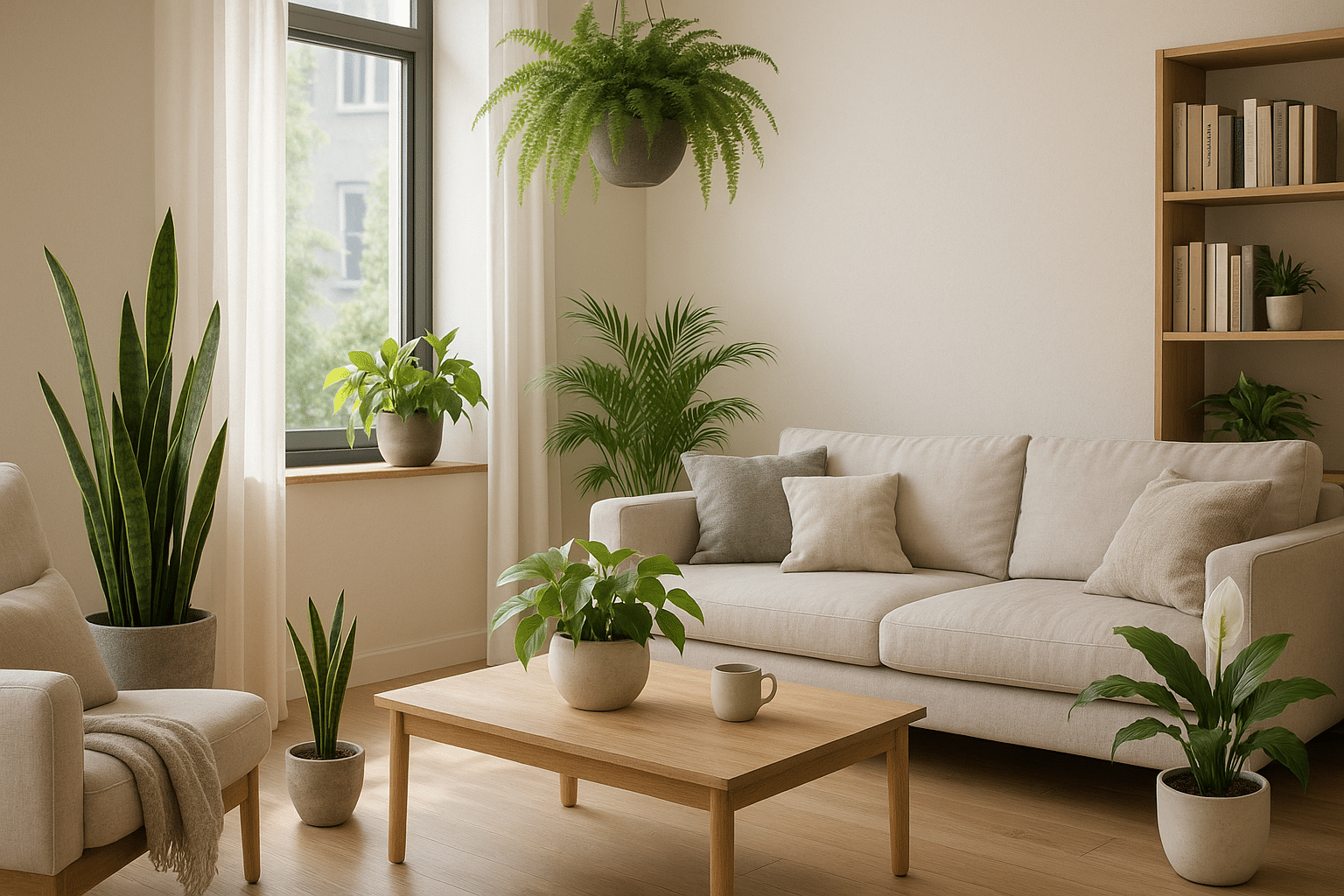🌿 But these aren’t just any houseplants. They are chosen specifically for their ability to purify the air and contribute to energy savings, making them the perfect blend of green and clean. In this article, we’ll dive deep into the realm of these wonder-plants, discussing their benefits, the science behind them, and how you can incorporate them into your home to create a healthier, more eco-friendly environment.
Why should you be interested, you ask? Well, to put it simply, the benefits of having these houseplants go beyond aesthetics. They can improve your health, save you money, and are an easy way to contribute to a greener Earth. 🌎
🍃 A Breath of Fresh Air: The Science Behind Houseplants
Before we jump into the types of houseplants and their specific benefits, let’s understand the science behind it all. Most of us remember from school that plants absorb carbon dioxide and release oxygen – a handy feature for humans who need oxygen to survive. However, NASA, in a landmark study, uncovered that some houseplants can also remove harmful toxins from the air. As we explore these plants, we’ll unpack this research and its implications for indoor air quality.
💡 Saving Energy and Money: The Green Side of Houseplants
But houseplants aren’t just about fresh air. They’re also about saving energy. Did you know that strategic placement of houseplants can reduce energy usage in your home? Or that certain types of plants can help regulate humidity levels, reducing the need for mechanical air conditioners or heaters? Throughout this article, we’ll delve into these topics, providing practical tips on how you can maximize these benefits.
🏡 Bringing it All Home: The Top Houseplants for Fresh Air and Energy Savings
Finally, we’ll delve into the heart of the matter: the top houseplants for fresh air and energy savings. We’ll provide an overview of each plant, discussing their air purifying and energy-saving capabilities, and how to care for them. By the end of this article, you should have a good understanding of which plants are best suited for your home, and how they can help you achieve a greener, cleaner lifestyle.
Ready to embark on this green journey? Good! Because houseplants are more than just pretty decorations. They’re hardworking, air-purifying, energy-saving machines. And they’re ready to make a difference in your home. 🏠
So sit back, grab a cup of tea ☕, and let’s dive into the world of green and clean houseplants!
🌱Embrace Nature’s Wonders: The Benefits of Indoor Plants
When we think about houseplants, we often associate them with interior design or simply a hobby. However, houseplants are so much more than mere aesthetic enhancements or a hobbyist’s delight. They are purifiers, energy savers, and a natural source of tranquility, all rolled into one. Join me in this journey where we delve deeper into the world of houseplants and uncover their hidden benefits. You might just find yourself a new green companion for your home by the end of this read.
The use of indoor plants for air purification isn’t a new concept. NASA’s Clean Air Study conducted in 1989 found that certain plants can remove harmful toxins from the air. This discovery has since initiated a renewed interest in the use of houseplants for indoor air quality improvement. In this article, we’ll explore some of the best houseplants for air purification and energy savings. To better understand the effectiveness of each plant, let’s refer to the comparative table below:
| Plant | Toxins Removed | Average Plant Life |
|---|---|---|
| Spider Plant | Formaldehyde, Xylene | 2-5 years |
| Snake Plant | Formaldehyde, Xylene, Benzene, Trichloroethylene | 5-10 years |
| Peace Lily | Ammonia, Benzene, Formaldehyde, Trichloroethylene | 3-5 years |
If you’re interested in learning more about how these plants purify the air, I’d recommend watching “How Plants Clean the Air in Our Homes” by SciShow on YouTube. Their engaging presentation style makes complex science accessible to everyone.
💡Illuminate Your Home: Houseplants and Energy Savings
Not only do houseplants purify the air, but they can also contribute to energy savings. How, you ask? Plants naturally regulate temperature. During the process of transpiration, plants release moisture into the air, which can lower the ambient temperature. By placing plants strategically in your home, you could potentially reduce your dependency on air conditioners and fans, thereby saving energy and reducing your carbon footprint.
Furthermore, houseplants can also help with light regulation. By positioning tall, leafy plants near windows, you can reduce glare and diffuse natural light. This could potentially reduce the need for artificial lighting and contribute to energy savings.
For a clearer understanding, let’s look at the comparative table below:
| Plant | Temperature Regulation | Light Diffusion |
|---|---|---|
| Ficus Tree | High | Moderate |
| Areca Palm | High | Moderate |
| Rubber Plant | Moderate | High |
If you’re looking for a detailed explanation of how plants help in temperature regulation, I’d recommend watching “How do plants cool down the Earth?” by TED-Ed on YouTube. It’s an eye-opener for sure.
🌿Create a Sanctuary: Houseplants for Well-being
Our homes are not just physical spaces, they are also emotional havens where we unwind and recharge. The presence of plants contributes to creating a calm and soothing atmosphere. Scientific studies have proven that plants can reduce stress levels, improve mood, and enhance concentration and productivity.
Furthermore, the act of caring for plants can also be therapeutic. It provides a sense of responsibility and a connection to other living beings. This can be especially beneficial for people living alone or those who cannot keep pets.
Let’s explore some of the best plants for promoting well-being:
- Aloe Vera: Known for its healing properties, Aloe Vera is also an excellent air purifier.
- Lavender: Lavender’s scent is known for its calming effects, making it perfect for inducing sleep.
- Rosemary: Rosemary is believed to improve memory and concentration, making it ideal for study areas.
For a more visual experience on how houseplants affect our well-being, watch “The Benefits of Houseplants” by Healthline on YouTube. It’s a visual treat with an abundance of useful information.
💚The Green Path: Ensuring Houseplant Success
Now that we have explored the various benefits of houseplants, it’s essential to ensure their survival. Different plants have different care needs, which can include light, water, and humidity levels. As a beginner, it might be a good idea to start with hardy, low-maintenance plants, such as Snake Plants or Spider Plants.
Furthermore, it’s essential to understand your home’s conditions. Is it bright and sunny, or does it lean more towards the cooler, shaded side? Understanding these factors will help you choose the right plant for your home. Remember, a healthy plant is more effective in purifying air and saving energy.
So why not make a start? Visit your local nursery, pick up a plant that resonates with you, and start your green journey. If you need a little guidance on how to take care of your new houseplant, check out “Beginner Houseplant Care” by Plant One On Me on YouTube. It’s filled with practical tips that can help you ensure your plant thrives.

Conclusion
To sum up the key points discussed in this article, it’s evident that technological advancement is shaping our world and impacting various industries, including Information Technology and Engineering. This article has walked you through numerous complex concepts related to these fields, all conveyed in a digestible and understandable manner. The aim was to not only inform you but also empower you to harness this knowledge for your benefit.
Firstly, we delved into the importance of IT in our modern world. In this digital era, IT is the backbone that supports businesses and organizations in their operations, enabling them to stay competitive. Whether it is data management, cybersecurity, or system analysis, every aspect of IT is essential for the successful functioning of any business.
Further, we examined the engineering field, particularly software engineering. The complexities of software development, from designing, coding, testing to maintenance, were laid bare. We underscored the crucial role that software engineers play in creating the digital infrastructure on which our society increasingly depends.
On the same note, we touched on the intersection of IT and Engineering, how these two disciplines intertwine and reinforce each other, creating synergistic effects that drive innovation and progress in our world. This synergy, as we’ve seen, is propelling us towards a future where everything from our cars to our home appliances could be connected and intelligent.
It’s imperative to realize that understanding these concepts is not just about acquiring knowledge; it’s about being part of the conversation, contributing to the discourse, and perhaps even influencing the trajectory of these fields. In a world increasingly reliant on technology, being tech-savvy is no longer optional but a necessity.
This article, therefore, serves as a starting point for anyone interested in delving deeper into the realms of IT and Engineering. Whether you’re a student considering a career in these fields, a professional seeking to enhance your skills, or a curious reader interested in understanding the technologies that shape our world, this article is for you.
So, what’s next? I encourage you to explore further, delve deeper. Perhaps there’s a particular concept in the article that piqued your interest? Maybe there’s a question you’d like answered? Or perhaps you’re inspired to apply some of the insights you’ve gained in your work or studies? Don’t hesitate to leave a comment, share the article with others, or use the knowledge you’ve gained to make a difference. The world of IT and Engineering is vast and full of possibilities – the sky is the limit! 🚀
Feel free to explore more on the topic from authoritative sources such as [MIT Technology Review](https://www.technologyreview.com/) and [IEEE Xplore](https://ieeexplore.ieee.org/Xplore/home.jsp). The more you learn, the better equipped you’ll be to navigate our technology-driven world.
In conclusion, it is a great time to be alive. We’re in the midst of a technological revolution, and each of us has a part to play. So let’s embrace the challenge, let’s continue learning, and let’s shape the future together. As Marie Curie once said, “Nothing in life is to be feared, it is only to be understood. Now is the time to understand more, so that we may fear less.”
References:
[MIT Technology Review](https://www.technologyreview.com/)
[IEEE Xplore](https://ieeexplore.ieee.org/Xplore/home.jsp)



